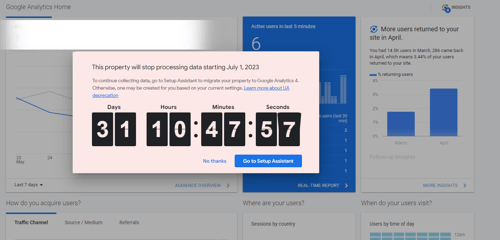You've been hearing all about how great Google Analytics 4 is but here are 5 things you should know before making the switch.
 Digital marketing is constantly evolving, making it crucial, and at times challenging, to stay ahead of digital trends and technologies. One recent seismic change in the digital marketing industry is the release of Google’s newest version of its analytics platform, Google Analytics 4 (GA4).
Digital marketing is constantly evolving, making it crucial, and at times challenging, to stay ahead of digital trends and technologies. One recent seismic change in the digital marketing industry is the release of Google’s newest version of its analytics platform, Google Analytics 4 (GA4).
Adoption of GA4 has taken place over the last year and a half as Google counts down to a July 1st deadline. However, here's the catch: while transitioning to GA4, what you may not realize is that you're losing essential features that you’ve come to rely on in Google’s Universal Analytics (UA), the previous generation of Google Analytics.
On July 1st, 2023, UA support will cease to exist, at which point Google will stop collecting data on UA. Nearly 30 million websites use Google Analytics, and this change impacts all of them.
How? Here at the top five features that marketers will lose that are integral to their digital marketing success when moving over to GA4.
- Demographic Reports: One of the most significant differences between GA4 and Universal Analytics is the lack of demographic reports in GA4. Marketers will no longer be able to see the age, gender, and interests of their website visitors. This information is valuable in tailoring content to specific audiences, and without it, marketers may have to rely on other data sources to gather demographic information about users on their websites. Demographic data from Google may have always been top level but many users relied on the insights.
- Goals and Funnel Visualization: In Universal Analytics, goals and funnel visualization allow users to track and visualize their website visitors' journeys from start to finish. GA4, however, takes a different approach by focusing on events and user interactions. This will undoubtedly make it more challenging for users to visualize their website visitors' journeys and make data-driven decisions on website optimization. You’ll gain more insights into devices and offline measurement but at the cost of understanding user behavior while on pages across a site.
- Remarketing: Remarketing is obviously a powerful tool for targeting users who visit your website. However, in GA4, remarketing relies on Google Ads rather than Google Analytics, a BIG shift. This means that marketers will need to set up their remarketing campaigns in Google Ads and may lose some of the insights they previously had in Universal Analytics. This represents a key change in the way Google will collect, display, and share data moving forward. Google has increasingly pushed marketers to trust in their machine learning and AI at the expense of calculated human decisions, something many marketers' using Goggle Ads have grappled with for some time.
- Enhanced eCommerce: Enhanced eCommerce is a valuable and frequently used feature in Universal Analytics that allows users to track and analyze their eCommerce website's performance. GA4 does not support Enhanced eCommerce currently. Which means e-commerce marketers will need to find other tools to track and analyze online sales data. This comes as a cookieless future looms on the horizon pushing for tools that allow greater insights to the buying journey. The days of pulling a report for Universal Analytics on top traffic patterns and sales from that traffic are over.
- Custom Reports: We all have our favorite Analytics views and dashboards, but unfortunately GA4 does not support custom reports yet. Which means marketers must accept the standard reports available in GA4 or use other tools to customize their data analysis.
.jpg?width=500&height=305&name=stephen-phillips-hostreviews-co-uk-shr_Xn8S8QU-unsplash%20(1).jpg) Although GA4 offers more behavior-driven features, it is inevitable that users will face challenges without Universal Analytics. They will lose access to familiar and valuable features like demographic reports, goals and funnel visualization, remarketing, Enhanced eCommerce, and custom reports.
Although GA4 offers more behavior-driven features, it is inevitable that users will face challenges without Universal Analytics. They will lose access to familiar and valuable features like demographic reports, goals and funnel visualization, remarketing, Enhanced eCommerce, and custom reports.
Google Analytics is still a powerful tool. However, there are gaps where digital marketers and decision-makers aren't getting the complete picture of the user journey and campaign performance. They don't need to replace Google Analytics, but instead augment it with alternative strategies or solutions to answer their unaddressed questions, such as:
- How can I easily tell where in the journey are the most customers falling out? And what's causing that to happen?
- What are the different journeys taken by different types of users on our site, like logged-in versus not logged-in users?
%20(1).png)
During the holiday rush, every shopper matters
Optimize the customer journey before the eCommerce event of the year.

.jpg)


